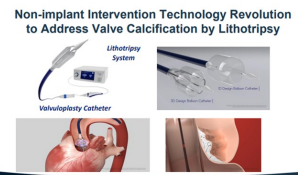
In the trial exploring the effectiveness and safety of using the SmartWave lithotripsy valvuloplasty technology to treat calcified severe AS, human aortic valve samples and rat calcified samples were utilized. The application of SmartWave significantly reduced the force required to produce a specific degree of curvature in valve samples, indicating an enhancement in the flexibility of calcified valves. MicroCT imaging revealed that the internal structure of calcified tissue showed fragmentation after SmartWave treatment, with a reduction in surface density of the calcified tissue and no soft tissue damage observed. Additionally, long-term animal experiments demonstrated that shockwave lithotripsy in large animals is feasible and does not adversely affect the hemodynamics of the left ventricle and aortic valve. Necropsy results at 31 days suggested no abnormalities in the area surrounding the aortic valve, with no thrombosis, infection, or further calcification formation, proving the good safety profile of SmartWave.
SmartWave has now completed 8 human trials, and patients have shown improved hemodynamics, with an overall performance of more than 40% improvement in postoperative transvalvular pressure difference or valve orifice area.
